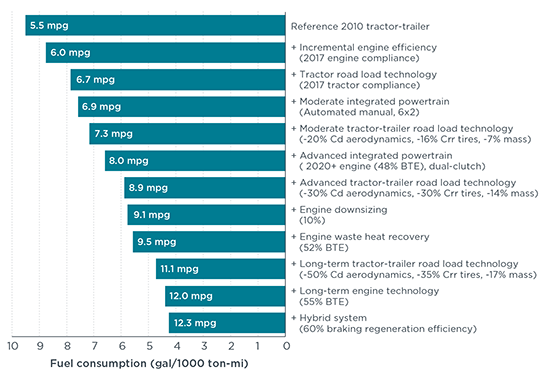Advanced tractor-trailer efficiency technology potential in the 2020–2030 timeframe
Blog
Eighteen wheels and ten miles per gallon
Over the past generation, a lot has changed for the workhorse of American freight-hauling, the eighteen-wheel big rig, officially known as the Class 8 long-haul tractor-trailer. One thing that hasn’t is their paltry fuel economy. The average tractor-trailer gets the same 6 miles per gallon of diesel that it did decades ago.
But increasingly there are clear signs that that, finally, is about to change too. The initial federal fuel economy standards for tractors, adopted three years ago, will push them to about 7 mpg by 2017. A Cummins-Peterbilt team has demonstrated a 10.7 mpg tractor-trailer prototype, which has logged hundreds of thousands of miles, and more recently a team led by Daimler topped that with a 12.2 mpg prototype. Volvo hasn’t unveiled any similar demo yet, but they appear to be on a similar path, and they are publicly committing to increasing their vehicles fuel efficiency and reducing their carbon footprint.
New vehicle prototypes aren’t the only way the trucking industry is tackling performance efficiency. Individual drivers are adding technology and improving their driving habits to achieve 10-11 mpg. Progressive fleets like Walmart are developing their own super-efficient tractor-trailers, including use of carbon fiber to save 4000 lbs, to help meet their sustainability goals. One innovative team even managed 13 mpg on a cross-country trip.
Private sector innovation is matched — and sometimes led — by public sector efforts. At the federal government level, the US Environmental Protection Agency and the National Highway Traffic Safety Administration, at the direction of President Obama, have been developing new standards to further increase truck efficiency for 2020 and beyond. The agencies have sent a regulatory package for the new standards to the Office of Management and Budget for review, and a new proposal could emerge in June. And the California Air Resources Board is convening an April 22 symposium to discuss how standards that promote these new heavy-duty sector technologies fit into their long-term emission-reduction plans.
How much more efficient might the new standards make tractor-trailers? We tackled that question in a just-released paper based on new engine data, inputs from industry leaders, careful analysis of results thus far in the SuperTruck program sponsored by the US Department of Energy (the source of those Cummins-Peterbilt and Daimler prototypes), and Autonomie-based vehicle simulation modeling to examine how the advanced technologies interact. The figure below, from that paper, encapsulates our results. The chart shows the sequential addition of advanced fuel-efficiency technologies to a reference 2010 tractor-trailer. Most of the technologies are either available already or emerging in the marketplace. The most advanced technology packages, similar to the US DOE Supertruck technologies, achieve about 11–12 mpg.

Potential fuel consumption reduction from tractor-trailer efficiency technologies in the 2020–2030 time frame
Will the technologies pay for themselves in fuel savings? They short answer is “yes.” In a companion paper, also just released, we analyzed all the levels of technologies that we considered in that technology potential paper. Our analysis indicates that the payback periods should be 18 months or less under all the average base-case economic assumptions. And the results are robust. Even if fuel prices somehow stay as low as $3.10 per gallon diesel indefinitely, using high discount rates of 10% and assuming high technology costs, the worst-case payback periods are still about two years. For a typical five-year tractor-trailer ownership period, the fuel-saving benefits would be 2–5 times greater than the technology costs for the most advanced 11–12 mpg technology packages. For the 8–9 mpg technology packages, and including the full technology lifetime, the benefit-to-cost ratios are much higher yet.

Payback periods for advanced tractor-trailer efficiency technologies in the 2020–2030 time frame
So will we see the 10-mpg tractor-trailer? Again, it appears as though the answer is “yes.” Based on our analysis, a 10-mpg tractor-trailer won’t be cheap—but neither is a 6 mpg rig. The costs will be reasonable, about $9,000–$14,000 on the purchase price of a new tractor and $1,000–$2,700 per new trailer. That’s on the order of a 14% increase in the retail tractor-trailer cost. But the benefits to nearly doubling the fuel efficiency of a new tractor-trailer combo are great—enough to recoup the initial costs in 18 months on average, as we’ve noted, and the subsequent fuel savings are all gravy. This could really be a big win for trucking fleets—and therefore for anyone who ever buys anything carried by those trucks, which is all of us.
